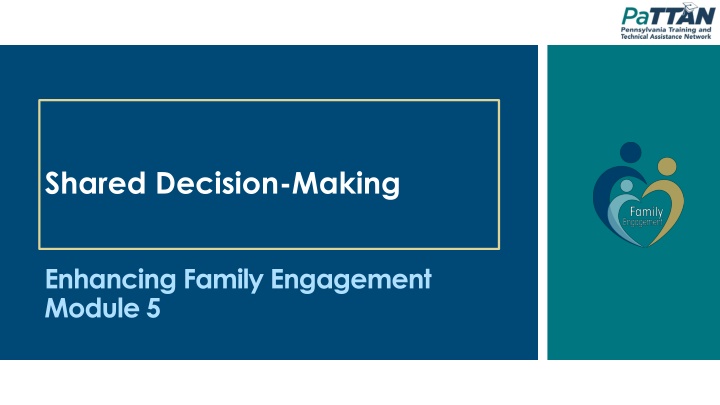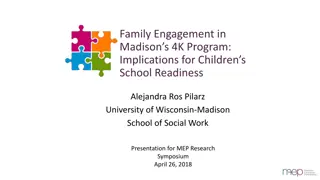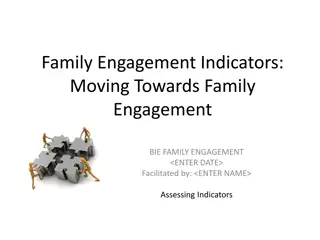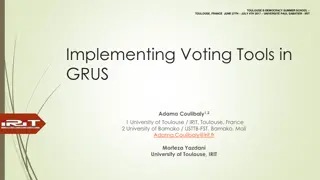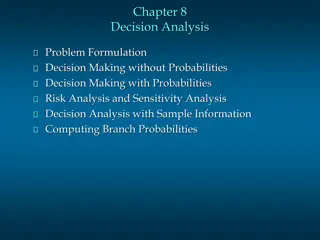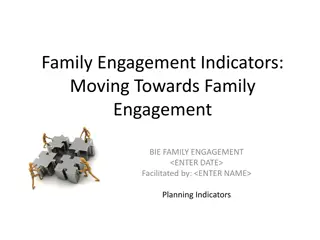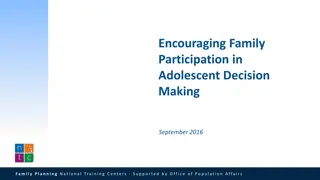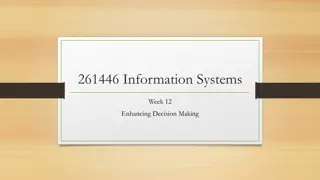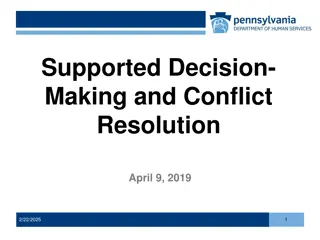Enhancing Family Engagement in Shared Decision-Making Module
Family Engagement plays a vital role in promoting equitable partnerships among schools, families, and communities to actively enhance student achievement through shared commitment, decision-making, and responsibility. Explore strategies to support shared decision-making practices within educational settings.
Download Presentation

Please find below an Image/Link to download the presentation.
The content on the website is provided AS IS for your information and personal use only. It may not be sold, licensed, or shared on other websites without obtaining consent from the author.If you encounter any issues during the download, it is possible that the publisher has removed the file from their server.
You are allowed to download the files provided on this website for personal or commercial use, subject to the condition that they are used lawfully. All files are the property of their respective owners.
The content on the website is provided AS IS for your information and personal use only. It may not be sold, licensed, or shared on other websites without obtaining consent from the author.
E N D
Presentation Transcript
Shared Decision-Making Enhancing Family Engagement Module 5
The mission of the Pennsylvania Training and Technical Assistance Network (PaTTAN) is to support the efforts and initiatives of the PaTTAN s Mission Bureau of Special Education, and to build the capacity of local educational agencies to serve students who receive special education services.
Our goal for each child is to ensure PDE s Commitment to Least Restrictive Environment (LRE) Individualized Education Program (IEP) teams begin with the general education setting with the use of Supplementary Aids and Services before considering a more restrictive environment.
Participants will: Identify research that supports shared decision-making Discuss shared decision-making and how to effect change within a school Evaluate current shared decision- making practices and determine areas of need Develop and implement strategies to promote shared decision-making Module 5 Goals
Family Engagement promotes equitable partnerships among schools, families and communities to actively promote student achievement through shared commitment, decision-making and responsibility. Family Engagement #PAFamilyEngagement
IDEA Regulations and Implications for Practice ESSA PA State Performance Plan (SPP) Indicator 8 Component 4C - Communicating with Families Danielson Framework Component 4A Maximizes Parent and Community Involvement and Outreach PA System for Principal Effectiveness
Image of the cover of A Parents' Guide to the Nation's Landmark Education Law. Understanding the Every Student Succeeds Act. ESSA Parent Guide Share with Your School Community!
All families have dreams for their children and want what is best for them. Core Beliefs of Family Engagement All families have the capacity to support their children s learning. Families and school staff are equal partners. The responsibility for cultivating and sustaining partnerships among school, home and community rests primarily with school staff, especially school leaders. Mapp, Carver & Lander, 2017
To recognize that both school staff and families share an important role in supporting positive school outcomes for children. Through shared decision-making, families are better able to meaningfully participate and contribute to successful outcomes for students. Purpose
Module 5: Shared Decision-Making The Importance of Family Engagement
Research repeatedly correlates family engagement with student achievement, yet this strategy is rarely activated as an integral part of school reform efforts. ~Weiss, Lopez, & Rosenberg, 2010 Family Engagement & Shared Decision- Making
Screenshot of an opening video The Dual Capacity-Building Framework version 2 Dual Capacity- Building Framework for Family-School Partnerships Version 2
Capabilities Connections The Four C s: LEAs build respectful and trusting relationships with families. Increase parent-to- parent networking and connections. Capabilities and Connections Increase connections to community agencies and services. Families build personal, educational, and professional skills.
Cognition Confidence An increased number of families and staff from diverse backgrounds take on positions of leadership at the school or in the community. Families and school staff indicate an increase in their comfort level and sense of self-efficacy when engaging in home school partnership events and activities. The Four C s: Families beliefs about the role they play in their student s education broaden to include multiple roles. Cognition and Confidence Staff and families belief systems about the value of home- school partnerships link to learning and school improvement.
Activity 5.1 The 4 Cs
Educators are empowered to: Connect family engagement to learning and development Engage families as co-creators Honor family funds of knowledge Create welcoming cultures Families engage in diverse roles: Co-creators Capacity Outcomes Supporters Encouragers Monitors Advocates Models ~Karen Mapp and Paul Kuttner
Shared responsibility, including shared decision-making Research on Successful Family Engagement Continuous across a child s life, from early childhood to young adulthood The Harvard Family Research project redefined successful family engagement as Cutting across and reinforcing learning in multiple settings, not just the school building
Conventional Methods of Engagement Attending school events Meeting with teachers Helping with homework Joining the PTA Volunteering (Mapp, Henderson, and Hill, 2014)
Providing families with information on what/how their children are learning, and effective strategies to use at home High-Impact Engagement Strategies Building and Fosteringrespectful and trusting relationships focused on shared responsibility Training families AND teachers in order to develop new skills and build dual capacity (Mapp, Henderson, and Hill, 2014)
Activity 5.2 Current Practices in Shared Decision- Making (Epstein et al, 2009)
Module 5: Shared Decision-Making Effecting Change in Our School
Partnerships in Power Partnership requires sharing power. (Henderson, Mapp, Johnson, and Davies, 2007)
Means: A process of partnership for excellent education and student success - not a power struggle of conflicting ideas Shared Decision Making in Schools Includes: Sharing views Solving problems Taking-action toward shared goals (Epstein, et. al, 2007)
Choice Shared Decision- Making Process Course of Action Consequence Commitment (Bitsko, Phipps, Roehrs, & Barnheiser)
Providing workable mechanisms for stakeholders to voice their ideas and concerns, and to take part in decision- making What Shared Decision- Making Looks Like Increasingfamilies knowledge and skill, and their connections to other families and people in the community Strengthening family links with community organizations and resources (Henderson, Mapp, Johnson, and Davies, 2007)
School Councils and committees School action teams for planning and research, including an action team for partnerships Independent advocacy groups to lobby/work for school reform Parent/Parent-Teacher associations Parent-School compacts/contracts Networks linking families with parent representatives Shared Decision- Making Mechanisms (Epstein et al, 2009)
Policy & Program Have a basic philosophical belief in the value, expertise, and knowledge gained from families Compensate families for their time, expertise, and expenses as appropriate Policy Level Be aware of and open to cultural differences between families and staff Keep families apprised of school projects and plans through phone calls and mailings
District Matters Provide clear information about the goals of the committee and the role of family members Provide accurate, timely, clear, jargon-free, and appropriate information prior to and after meetings District Level Increase family membership on committees Ensure diversity among the membership by recruiting broadly from the community
Advisory Role Convene focus groups of families as specific issues arise Hold monthly family/staff coffee hours School Level Hold brainstorming sessions with families before developing educational materials Keep a suggestion book in the office so families can record their ideas Invite families to present at in-service programs for staff
Benefits for Students Recognize the presence of family representation Understand the protection of their rights Benefits for Teachers Include family perspectives and collaboration Create equal representation for family leadership Benefits for Parents Influence school decision-making with their voice Connect with other families Impact of Shared Decision- Making (Epstein et al, 2009)
Decisions About Who Makes Decisions? What should the ratio of family members to school staff on decision-making team be? Why Families Are Involved/ Are Not Involved Procedures Ex. Student Drop Off Activity 5.3 Who? What? Why? Programs Ex. 6th Grade Orientation Partnerships Ex. Local Police Department Policies Ex. Bring Your Own Device
Module 5: Shared Decision-Making Strategies for Teaming with Families
Involve Families in Decisions Regarding Issues Such As: Strategies That Promote Team Building Students needing more support than what is provided in general education The School staff considering looping Changes in extracurricular activities The addition of an alternate school program Participation in field trips or other activities away from school (Working Together Toolkit, 2011)
Highly motivated individuals with a common interest Ownership and responsibility for shared tasks Collaborativediscussions to find solutions to problems Clearly identified areas of major concern/community Responsive and respectful rules for communication Available resources to achieve identified goals An Effective Team Has (Working Together Toolkit, 2011)
Site-based school advocacy management council Parent advisory committee for a program such as a reading program, the bilingual program or the school library PTA/PTO or classroom committee Task force organized around an issue Search committee for a principal or program leader Planning committee for the school or one of its programs Types of Decision- Making Entities (Working Together Toolkit, 2011)
Shared Decision-Making Activity 5.4 Promoting Shared Decision-Making
Bitsko, S., Phipps, D., Roehrs, A., & Barnheiser, M. (n.d.). Parent Involvement: Strategies for Success. Retrieved October 21, 2015. http://ddc.ohio.gov/Pub/ESCParent.htm. Danielson, C. (2011). The Framework for Teaching Evaluation Toolkit. Retrieved January 14, 2015. http://www.pdesas.org/Instruction/Frameworks. References and Resources Epstein, J.L. et al. (2009). School, Family, and Community Partnerships, 3e. School, Family, and Community Partnerships: Your Handbook for Action, 3e. Thousand Oaks, CA: Corwin Press. Henderson, A. T., Mapp, K. L., Johnson, V. R., & Davies, D. (2007). Beyond the Bake Sale: The essential guide to family-school partnerships. New York, NY: The New Press. Mapp, K., Henderson, A., & Hill, N. (2014, May 15). Does Family Engagement Matter? The Truth and Half-Truths about Parent Involvement. Retrieved October 20, 2015. http://www.teachingforchange.org/does-family- engagement-matter.
Mapp, K. L., & Kuttner, K. L. (2013). Partners in Education: A Dual Capacity- Building Framework for Family-School Partnerships. Austin: SEDL. References and Resources cont. Morales-James, C., Lopez, L.; Wilkins, R.; Fergus, E. Cultural adaptations when implementing RTI in urban settings. Retrieved February 24, 2015 from http://www.rtinetwork.org/learn/diversity/cultural-adaptations-when- implementing-rti-in-urban-settings. "Supporting Decision Making and Advocacy." Working Together Toolkit. Center for the Education and Study of Diverse Populations, 2011. Web. 22 Oct. 2015. Weiss, H.B., Lopez, M.L, & Rosenberg, H. (2010). Beyond Random Acts: Family, School, and Community Engagement as an Integral Part of Education Reform. Retrieved January 14, 2015, from http://www.hfrp.org/publications-resources.
PaTTAN East 1-800-441-3215 Kimberly Jenkins kjenkins@pattan.net PaTTAN Harrisburg 1-800-360-7282 Erin Campion ecampion@pattan.net Commonwealth of Pennsylvania Tom Wolf, Governor PaTTAN Pittsburgh 1-800-446-5607 Jennifer Geibel jgeibel@pattan.net
